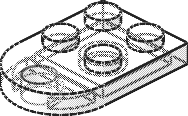Subject:
|
Re: A castle fan's Train plan
|
Newsgroups:
|
lugnet.trains
|
Date:
|
Wed, 15 Mar 2006 20:07:08 GMT
|
Viewed:
|
4720 times
|
| |

|
|
In lugnet.trains, Anthony Sava wrote:
Your welcome, I haven’t actually built a steem engine this large, but I’ve been
collecting ideas.
| |
I had already planned on purchasing the blind drivers, but I was planning on
having my drive wheel arrangement with a flanged driver first. Why do you
suggest having a blind wheel first? Do the pistons hide the ‘float’?
|
This is a long engine and unless you are articulating the boiler you’ll want to
balance the swing out at each end of the engine. The simple methode is to place
the center point between the flanged wheel sets as close to the center of the
engine as possible. Scince the drive wheels are quite forward on the engine, I
recomend placing the blind drivers first.
If you want to improve this even more, reverse the order on the drivers. Build
the pistons as part of the driver wheel set, ot the engine. Pivot the leading
wheels as before. Treat the leading wheels and driver/piston combination as one
large truck. Build the rear wheels as a seperate truck. The have the rest of the
engine rides on these two trucks. This will reduce the swing out at each end by
introducing some at the middle. I think it may be more reliable as well.
| |
I know the leading wheels need to be on one pivot at the end of a connecting
arm, but what about the rear wheels? Should they have a single pivot at the
end of a connecting arm, or a double pivot at both ends of the arm (where it
attaches to the engine and where it attaches to the trailing wheels)?
|
In the first methode, the trailing truck ataches to the driver wheels, not the
engine. Test bothe a single pivot and a double, but I think the double will work
better. In the second method it’s a non issue, the trailing wheels attch to the
engine as on a rail car.
| |
What would you recommend on connecting the tender to the engine? Using a
pair of LEGO’s buffers and magnets, just a pair of magnets by themselves, or
a drawbar?
|
I recomend magnets and treating them as two cars. This should make it easier to
place these on the track and remove for storage. But a drawbar should work as
well. I’d avoid using the buffer plates, as they are very none US prototypical.
Enstead I use these.
 3176 3176
 48995 48995
Mat
|
|
Message has 2 Replies:
 | | Re: A castle fan's Train plan
|
| This is my wheelbase: (URL) For this engine: (URL) Train>> I'm not actually using blind wheels; I make the middle wheels able to flex in, but it's extremely fiddly and you're better off with blind ones. The main thing this wheelbase does is attach (...) (20 years ago, 15-Mar-06, to lugnet.trains, FTX)
|
Message is in Reply To:
 | | Re: A castle fan's Train plan
|
| (...) Thanks for the pointers! I had already planned on purchasing the blind drivers, but I was planning on having my drive wheel arrangement with a flanged driver first. Why do you suggest having a blind wheel first? Do the pistons hide the (...) (20 years ago, 15-Mar-06, to lugnet.trains, FTX)
|
16 Messages in This Thread:
  
        
     
    
    
          
  
  
- Entire Thread on One Page:
- Nested:
All | Brief | Compact | Dots
Linear:
All | Brief | Compact
This Message and its Replies on One Page:
- Nested:
All | Brief | Compact | Dots
Linear:
All | Brief | Compact
|
|
|
|